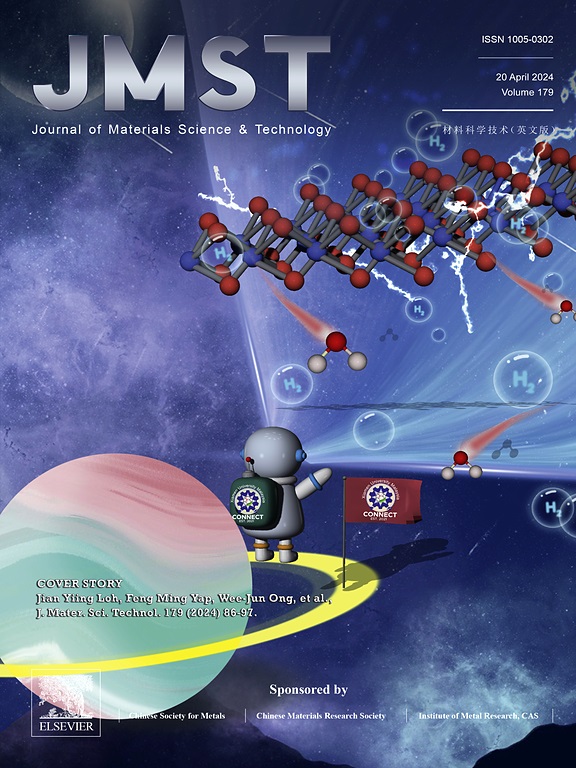Effect of heat treatment on microstructure evolution, strengthening-toughening and corrosion behavior of high-strength LA103Z Mg-Li alloy fabricated by wire-arc additive manufacturing
IF 11.2
1区 材料科学
Q1 MATERIALS SCIENCE, MULTIDISCIPLINARY
引用次数: 0
Abstract
This study investigated the effects of heat treatment on the mechanical and corrosion properties of cold metal transfer-based wire arc additively manufactured (CMT-WAAM) LA103Z magnesium-lithium alloy. The results demonstrated that both solid solution treatment and aging treatment improved the mechanical properties of the alloy, while the corrosion resistance of the solid solution-treated alloy was significantly enhanced. The solid solution treatment (340°C) dissolved the fine needle-like α-Mg and AlLi phases, and the Li2MgAl phase precipitates were dispersed. The ultimate tensile strength of the solution-treated alloy increased significantly from 144 ± 6.2 MPa to 299 ± 1.2 MPa, an increase of almost 107.6%. The high-temperature (225°C) aging treatment made the alloy grain distribution more uniform, caused the AlLi phase particles to gradually coarsen, and transformed the Li2MgAl phase into a substantial quantity of fine AlLi phase particles. The yield strength increased from 100 ± 5.0 MPa to a maximum of 182 ± 2.6 MPa, representing an approximately 82% increase, while the maximum elongation reached 24.1% ± 2.0%. The electrochemical test results showed that the fine equiaxed grains and uniformly distributed fine needle-like α-Mg phase in the As-built sample reduced micro galvanic corrosion sensitivity and enhanced corrosion resistance compared to the rolled sample. The AlLi phase particles in the solid solution-treated sample were nearly completely dissolved, leading to a significant reduction in micro-galvanic corrosion between the secondary phases and the matrix. Corrosion primarily occurred along the interface between the α-Mg and β-Li phases, exhibiting filamentary corrosion, and the sample showed the highest corrosion resistance. In contrast, the samples subjected to direct high-temperature aging and solution treatment followed by aging exhibited exacerbated local corrosion due to the coarsening of the AlLi phase and the increased amount of precipitation.

热处理对线弧增材制造高强LA103Z Mg-Li合金组织演变、强韧化和腐蚀行为的影响
研究了热处理对冷金属转移基电弧增材制造(CMT-WAAM) LA103Z镁锂合金力学性能和腐蚀性能的影响。结果表明,固溶处理和时效处理均能提高合金的力学性能,而固溶处理的合金的耐蚀性显著增强。固溶处理(340℃)溶解了细小的针状α-Mg和AlLi相,Li2MgAl相析出分散。固溶处理合金的抗拉强度从144±6.2 MPa显著提高到299±1.2 MPa,提高了近107.6%。高温(225℃)时效处理使合金晶粒分布更加均匀,AlLi相颗粒逐渐变粗,Li2MgAl相转变为大量细小的AlLi相颗粒。屈服强度从100±5.0 MPa提高到182±2.6 MPa,最大伸长率达到24.1%±2.0%,提高了约82%。电化学测试结果表明,与轧制样品相比,As-built样品中细小的等轴晶和均匀分布的细针状α-Mg相降低了微电蚀敏感性,提高了耐蚀性。固溶处理样品中的AlLi相颗粒几乎完全溶解,导致二次相与基体之间的微电偶腐蚀显著减少。腐蚀主要发生在α-Mg相和β-Li相界面,呈丝状腐蚀,耐蚀性最高。而经直接高温时效和固溶后再时效处理的样品,由于AlLi相的粗化和析出量的增加,局部腐蚀加剧。
本文章由计算机程序翻译,如有差异,请以英文原文为准。
求助全文
约1分钟内获得全文
求助全文
来源期刊

Journal of Materials Science & Technology
工程技术-材料科学:综合
CiteScore
20.00
自引率
11.00%
发文量
995
审稿时长
13 days
期刊介绍:
Journal of Materials Science & Technology strives to promote global collaboration in the field of materials science and technology. It primarily publishes original research papers, invited review articles, letters, research notes, and summaries of scientific achievements. The journal covers a wide range of materials science and technology topics, including metallic materials, inorganic nonmetallic materials, and composite materials.
 求助内容:
求助内容: 应助结果提醒方式:
应助结果提醒方式:


